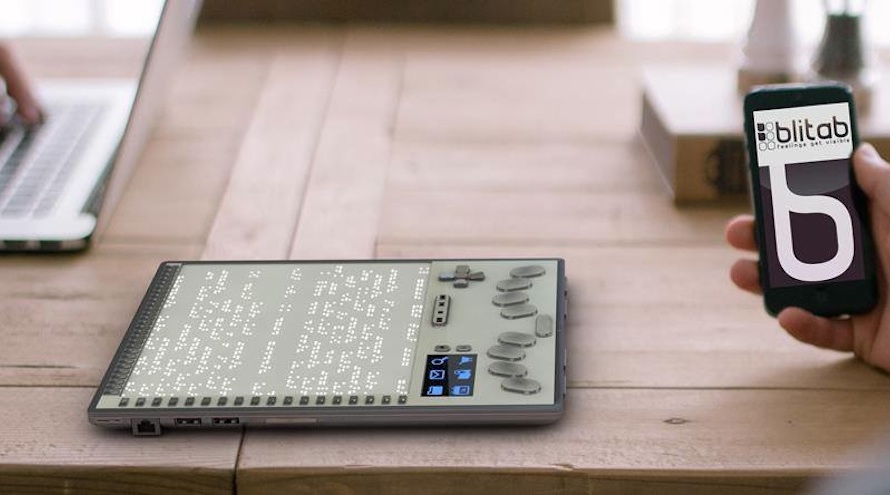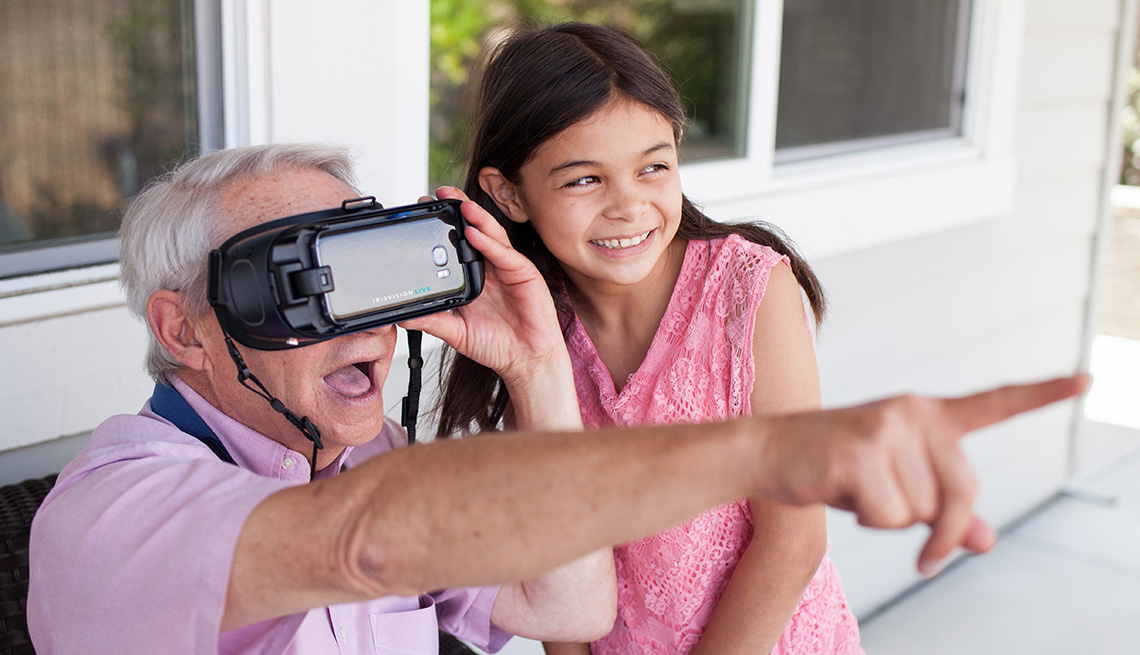Discover Cutting-edge Devices Developed for the Aesthetically Impaired
The advancement of cutting-edge devices for the visually damaged represents a substantial improvement in availability and self-reliance. Technologies such as clever glasses with AI capabilities and mobile applications developed to give auditory summaries are improving everyday experiences for users. In addition, wearable gadgets that employ haptic feedback boost ecological understanding, while contemporary Braille developments provide new methods to engage with text. As these devices remain to develop, their effect on the lives of those with visual disabilities elevates important inquiries regarding the future of inclusivity and autonomy in different aspects of life. What exists ahead in this technological landscape?
Smart Glasses for Navigating

Smart glasses developed for navigation are revolutionizing the method aesthetically impaired individuals interact with their atmosphere. These innovative tools utilize a mix of camera technology, synthetic knowledge, and auditory comments to supply real-time info regarding environments. By utilizing barrier detection systems, smart glasses can signal users to prospective hazards, allowing more secure flexibility in both unknown and acquainted setups.
The combination of GPS innovation additionally enhances navigating capabilities, allowing users to obtain auditory instructions as they move. This hands-free approach not just fosters freedom yet likewise encourages aesthetically impaired individuals to browse metropolitan landscapes with boosted confidence. In addition, numerous wise glasses are outfitted with functions that determine sites and road indications, offering contextual info that enhances the customer experience.
Furthermore, the growth of these tools is constantly progressing, with firms functioning to enhance the accuracy of object recognition and expand the array of navigational features. As wise glasses become more available and budget friendly, they hold the potential to substantially change everyday life for aesthetically impaired individuals. Ultimately, these cutting-edge devices stand for a vital action toward inclusivity, offering boosted flexibility and a higher sense of autonomy for people browsing the globe around them.

Mobile Apps for Daily Living
Just how can mobile applications improve the every day lives of visually impaired individuals? Mobile applications are changing the means aesthetically damaged customers navigate their atmospheres, take care of daily jobs, and gain access to information. These applications give necessary support through numerous performances, fostering independence and improving top quality of life.
A number of innovative mobile applications are made particularly for everyday living. As an example, apps like Be My Eyes connect aesthetically damaged users with sighted volunteers by means of video telephone calls, permitting them to obtain real-time help with tasks such as reading labels or navigating strange spaces. In A Similar Way, Seeing AI, created by Microsoft, utilizes expert system to describe surroundings, reviewed message, and determine objects, properly changing a smartphone into a powerful device for day-to-day help.
Furthermore, navigating applications tailored for the aesthetically damaged, such as Aira and BlindSquare, use audio-based directions and ecological information, enabling individuals to traverse their surroundings securely and with confidence. Beyond navigating and prompt assistance, mobile apps additionally sustain organization and job monitoring, with features that aid customers establish tips, create order of business, and track consultations. In summary, mobile applications work as important sources, encouraging aesthetically damaged individuals to lead more independent and meeting lives.
Wearable Technologies for Assistance
Empowerment through innovation is increasingly noticeable in the world of wearable devices designed to aid visually damaged individuals. These cutting-edge devices integrate flawlessly into everyday life, boosting navigating and supplying vital feedback to customers. Clever glasses geared up with video cameras can check out and acknowledge faces message aloud, permitting users to connect even more with confidence in specialist and social setups.
An additional notable improvement is using haptic comments systems in wearable gadgets. These systems utilize resonances or various other responsive signals to convey details concerning the customer's atmosphere, such as obstacles or changes in surface, improving wheelchair and safety. Wearable modern technologies additionally include wristbands that link to smart devices, notifying individuals to notifications through subtle resonances, thus boosting connectivity without reliance on visual cues.
As these technologies proceed to develop, they are not just boosting freedom for visually impaired individuals but likewise fostering a higher sense of inclusion in culture. By linking the gap in between difficulties faced in day-to-day living and the possibility for autonomy, wearable technologies function as crucial tools in the pursuit for equal rights and empowerment for those with aesthetic disabilities.
Sound Summary Devices
Sound description devices play a critical function in enhancing availability for aesthetically damaged individuals, giving them with the capacity to involve with aesthetic media. Smart glasses for the visually impaired. These tools provide narrated descriptions of essential aesthetic components in films, tv shows, and live performances, making sure that users can totally understand the context and feelings communicated with visuals
Audio description can Recommended Reading be incorporated into numerous platforms, consisting of streaming solutions, movie theater testings, and live cinema. Several prominent streaming solutions currently consist of audio description as an ease of access attribute, enabling audiences to select it conveniently. In addition to conventional media, specialized applications additionally exist, giving audio descriptions for art events, galleries, and other cultural occasions.
The efficiency of audio description pivots on the skill of the narrators, that should share aesthetic details succinctly without interfering Check Out Your URL with the original audio. Advancements in this field are additionally leading the means for even more customized experiences, where customers can adjust the level of detail and pacing according to their choices.
Braille Innovations and Devices
Braille developments and devices have actually substantially changed the method aesthetically impaired people engage with text and info. Modern developments have actually resulted in the development of flexible tools that boost proficiency and freedom amongst customers. Notably, Braille show innovations have actually progressed, permitting vibrant reading experiences. These tools convert electronic text right into Braille, allowing users to access a substantial variety of details on smart devices, computers, and tablet computers.
In addition, portable Braille notetakers incorporate traditional Braille input with modern-day capabilities, helping with note-taking, scheduling, and document editing and enhancing on the move. Mobility aids for visually impaired users. These portable gadgets commonly feature text-to-speech abilities, connecting the void between Braille and acoustic details
Additionally, ingenious Braille printers have emerged, allowing users to produce Braille tags, documents, and instructional products successfully. This access cultivates higher engagement in specialist and academic atmospheres, eventually promoting inclusivity.
Moreover, research into wise Braille innovations proceeds to expand. Tools that incorporate expert system are being discovered to offer real-time navigation assistance and contextual information, boosting the user experience in varied setups. On the whole, these developments show a dedication to empowering visually impaired individuals through innovation, ensuring they can easily gain access to and involve with the world around them.

Verdict
The advancement of cutting-edge tools for the visually impaired considerably boosts self-reliance and quality of life. These modern technologies not just foster greater incorporation yet also promote freedom in daily tasks, eventually adding to a more fair and easily accessible culture for aesthetically impaired people.
As clever glasses end up being more cost effective and obtainable, they hold the prospective to significantly transform everyday life for aesthetically damaged individuals. Mobile applications are transforming the means visually damaged customers browse their environments, take care of everyday tasks, and gain access to information. Apps like Be My Eyes connect visually impaired users with sighted volunteers using video clip telephone calls, permitting them to receive real-time assistance with jobs such as reading tags or navigating unfamiliar spaces.Furthermore, navigation applications tailored for the aesthetically see this website damaged, such as Aira and BlindSquare, supply audio-based directions and environmental info, enabling users to traverse their environments securely and confidently.The innovation of ingenious tools for the visually damaged substantially enhances independence and top quality of life.